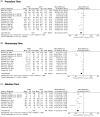The superiority of high-power short-duration radiofrequency catheter ablation strategy for atrial fibrillation treatment: A systematic review and meta-analysis study
- PMID: 34386124
- PMCID: PMC8339091
- DOI: 10.1002/joa3.12590
The superiority of high-power short-duration radiofrequency catheter ablation strategy for atrial fibrillation treatment: A systematic review and meta-analysis study
Abstract
Background: Radiofrequency catheter ablation (RFCA) using the high-power short duration (HPSD) results in better ablation lesion formation in the swine model. This systematic review and meta-analysis purposed to investigate the safety and efficacy profile between HPSD and low-power long-duration (LPLD) ablation strategies to treat atrial fibrillation (AF) patients.
Methods: We completed the literature review after identifying the relevant articles comparing HPSD and LPLD ablation methods for AF recorded in ClinicalTrials.com, CENTRAL, PubMed, and ScienceDirect until February 2021. The overall effects were calculated using pooled risk ratio (RR) and mean difference (MD) for categorical and continuous data, respectively. We also estimated the 95% confidence interval (CI).
Results: The HPSD strategy took shorter procedure time (MD = -33.75 min; 95% CI = -44.54 to -22.97; P < .01), fluoroscopy time (MD = -5.73 min; 95% CI = -8.77 to -2.70; P < .001), and ablation time (MD = -17.71; 95% CI = -21.02 to -14.41) than LPLD strategy. The HPSD RFCA was correlated with lower risk of esophageal thermal injury (RR = 0.75; 95% CI = 0.59 to 0.94; P = .02). The HPSD method resulted in higher first-pass pulmonary vein isolation (PVI) (RR = 1.36; 95% CI = 1.13 to 1.64; P < .01), lower PV reconnection (RR = 0.47; 95% CI = 0.34 to 0.64; P < .01), and lower recurrent AF (RR = 0.72; 95% CI = 0.54 to 0.96; P = .02) than LPLD strategy.
Conclusion: HPSD RFCA was superior to the conventional LPLD RFCA in terms of safety and efficacy in treating AF patients.
Keywords: atrial fibrillation; catheter ablation; high‐power short duration; low‐power long‐duration; meta‐analysis.
© 2021 The Authors. Journal of Arrhythmia published by John Wiley & Sons Australia, Ltd on behalf of Japanese Heart Rhythm Society.
Conflict of interest statement
All authors declare no conflict of interest regarding the publication of this article.
Figures





References
-
- Packer DL, Mark DB, Robb RA, Monahan KH, Bahnson TD, Poole JE, et al. Effect of catheter ablation vs antiarrhythmic drug therapy on mortality, stroke, bleeding, and cardiac arrest among patients with atrial fibrillation: the CABANA randomized clinical trial. JAMA. 2019;321:1261–74. 10.1001/jama.2019.0693 - DOI - PMC - PubMed
-
- Hindricks G, Potpara T, Dagres N, Arbelo E, Bax JJ, Blomström‐Lundqvist C, et al. 2020 ESC guidelines for the diagnosis and management of atrial fibrillation developed in collaboration with the European Association of Cardio‐Thoracic Surgery (EACTS). Eur Heart J. 2021;42:373–498. 10.1093/eurheartj/ehaa612 - DOI - PubMed
-
- Macle L, Frame D, Gache LM, Monir G, Pollak SJ, Boo LM. Atrial fibrillation ablation with a spring sensor‐irrigated contact force‐sensing catheter compared with other ablation catheters: systematic literature review and meta‐analysis. BMJ Open. 2019;9:e023775:10.1136/bmjopen-2018-023775 - DOI - PMC - PubMed
LinkOut - more resources
Full Text Sources

